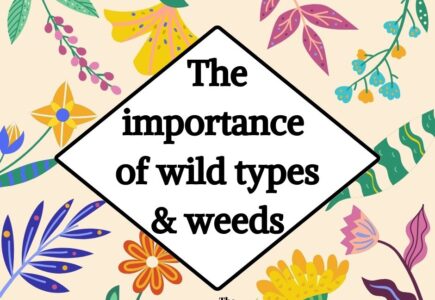While the vast majority of crops produced in Canada have been introduced from elsewhere, there is a lack of wild type relatives existing in nature for these crops. This is not the case in many other parts of the world where plants used for domesticated food production have wild types that bear genetic similarity. In cereals for example, these are often referred to as weedy relatives and chemicals are used to control them in crop production, so that they don’t reduce crop yields.
While these wild types of trees and shrubs and weedy relatives of crops have no commercial value, they may offer genetic value. Some genes provided benefits to the ancestors of our current plants, but as domestication happened and higher yields selected, these genes were targeted for removal. As an example, cereal weedy relatives naturally release their seeds into the environment. When it comes to using plants to feed ourselves, this is not a desirable trait, so the genetic trait for releasing seeds has been bred out of wheat, oat, and barley varieties.
As the ability to sequence plant genomes has become faster and cheaper, researchers are now turning to wild types and weedy relatives, sequencing them, to better understand what advantageous traits exist in these varieties for current varieties and food production within changing climates. Wild types and weedy relatives that have already been sequenced have been found to have disease resistance traits that are superior to domesticated varieties and through the use of gene editing technologies, these higher levels of disease resistance can be transferred to domestic varieties in one season.
It’s not only disease resistance that can benefit, but drought tolerance as well. We’ve all seen weeds in the midst of a drought that are far greener than any other plants surrounding them. If genes for drought tolerance in weeds could be identified through sequencing, then this tolerance level could be recreated and commercialized within our domestic crops within a few years. Innovations such as this offer tremendous potential for increasing food production within greater climate variability.
The integration of these two innovations, genetic sequencing and gene editing, offers tremendous potential for strengthening current crop varieties. Nature’s attack on crop varieties through greater insect and disease damage, is relentless. The use of gene editing to confer greater levels of resistance from relative species to domesticated crops, offers the potential for substantial yield increased within the short term. Insects and disease can have devastating yield effects, so being able to increase resistance to these threats by replicating genes found in nature, offers a low cost and proven solution to reducing the threats facing crop production.
Innovation drives increased output. This is true in the production of all kinds of products, including food. Without innovation, agriculture would be stuck where it was in 1960, capable of producing food for 3 billion people. Because of innovation in agriculture, we now adequately feed an additional 4 billion people, while a further 1 billion receive partially sufficient levels of food. Efforts are urgently needed to ensure the 1 billion that are food insecure experience better food availability and the integration of genetic trait research with gene editing is poised to be able to make significant contributions.


